Jeans are versatile clothing that is worn often and in different situations. Jeans wear out, holes appear on them, regardless of the price of the product. You can sew or darn jeans when holes appear between the legs, on the pockets or knees using a machine or by hand. Both methods have several options.
Why do jeans wear out between the legs?
There are several reasons why scuffs and holes appear on jeans between the legs:
- Body shapes. Excess volume in the hip area, caused by heavy weight or increased muscle mass, leads to strong tension of the fabric when worn. In addition, with voluminous hips, the gap between the inner parts of the thighs usually disappears, which leads to the legs rubbing against each other along the entire length of the thigh.
- Manner of walking. A gait in which the legs touch each other on the inside. The fabric may wear through both in the crotch and in the knees.
- Textile. The thicker the fabric, the less it is subject to external loads. Artificial threads of elastane or polyester make the material stronger. While jeans made of thin denim will not have a long service life, especially if there are other reasons that contribute to the wiping of trousers.
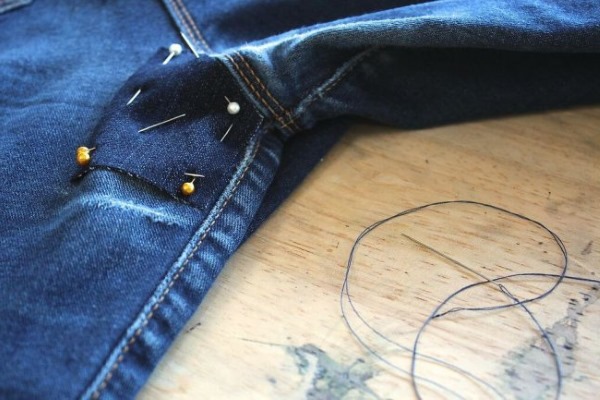
- Sedentary work. Sitting still for hours is difficult, so the average person fidgets in their chair from time to time, shortening the life of their jeans.
- Washing mistakes. Denim fabrics should not be washed in very hot water. The manufacturer's recommendations and those on the label should be taken into account. If there is no such information, the water temperature should not be higher than 45°C.
You also need to make sure that during drying the legs are turned inside out and that they are not exposed to direct sunlight.
What to do to prevent jeans from wearing out between the legs
To ensure that jeans last a long time, you should follow certain selection rules even at the purchasing stage:
- Tight models wear out faster, so it is better to choose more spacious pants.
- Jeans with a high waist or a standard waist are more durable. This is due to their better fit and even distribution of the load on the fabric. Conversely, low-waist models will wear out in the crotch faster.
- When doing sedentary work, it is recommended to choose trousers made of thick denim. And also knowing about the problem of abrasion, you should control your own movements as much as possible. For example, do not "slide" your butt on the chair, but stand up if you need to get something or bend over.
- It is advisable not to let the jeans get to the point where holes appear. As soon as scuffs and thinning of the fabric become noticeable, you should immediately take measures - strengthen the fabric.
How to Repair Jeans by Hand
To repair jeans, you don’t have to be an experienced seamstress; you just need to be able to hold a thread and a needle and make simple seams with them.
What you will need for the job
The threads that you need to choose for sewing on denim fabric must be highly durable.
Threads from the following manufacturers have proven themselves well:
| Firm | Threads |
| Aman | Saba 50, Saba 35, Saba 30, Rasant 75 |
| Gutermann | H120, H75, H35 |
| Coats | Epic 60, T-80N, T-60 |
| Rain Bow | A 202/120 |
If these names are not available in the store, then the choice should be made in favor of spools with an inscription indicating increased strength. If the threads are cotton, numbers 50-80 will do. Synthetic threads - 50-60.
To repair jeans, you should use needles with numbers 11 or 14 and a sharp end.If you do not plan to make a decorative patch, you need to use denim fabric of the most identical color or any other fabric that matches the shade. You will also need scissors and pins.
Patch
To make a classic patch, you will need 2 pieces of fabric. The first will be used as a lining, so it can be any color. The second, if possible, should be matched to the jeans, then the patch will be less noticeable. However, it is impossible to completely disguise a patch, so patches are often made more noticeable.
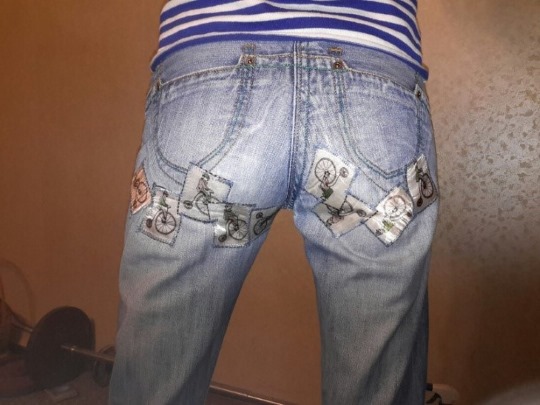
Stages of work:
- From both pieces of fabric, you should cut out patches that are large enough to cover the damaged area and leave 1 cm for hemming.
It is not necessary to fold the bottom flap if the fabric is not loose. Also, if the chosen piece of material is very dense, then the fold will add unnecessary volume, which can sometimes even rub the body when worn.
- It is recommended to sew the lower patch on the machine. To do this, the patch should be pinned to the pants, then sewn along the perimeter on the machine. Next, you need to lay lines in different directions inside this perimeter for better attachment of the fabric to the jeans.
- The outer patch needs to have its edges folded in so that the remaining fabric covers the hole and ironed. Then attach the patch to the jeans using a thread or pins.
- You can sew on a patch using any stitch, from a blind stitch to hide the threads to a loop stitch, which will make the finished edge more visible.
General tips for suturing
If the problem of holes and abrasions between the legs of jeans is constant, then it is recommended to strengthen this area of the pants immediately after purchasing the product and washing it for the first time.
You should also not wait until a scuff turns into a hole or a small hole becomes a big one. Taking preventive measures will increase the lifespan of your jeans.
You should be careful when choosing the fabric for the lining. For example, thick material or dense denim may rub the body later, especially if the jeans are narrow. To make the repair of trousers less noticeable to others, you should take the time to find sewing threads that repeat the color of the fabric.
Sewing the edges
When the hole is small, has a longitudinal shape and does not have torn edges, it can be sewn up with an over-the-edge stitch.
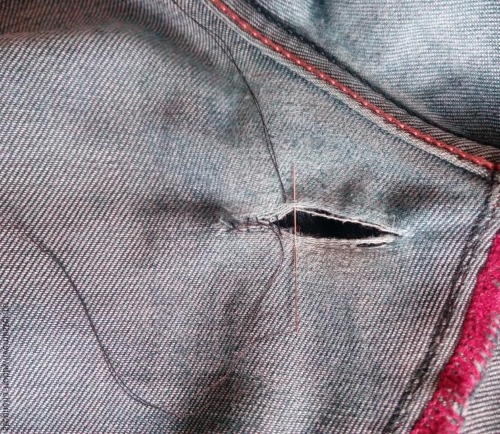
To ensure greater strength, it is recommended to first sew a running stitch along the edge.
Strengthening the hole
Sometimes a hole needs to be reinforced rather than sewn up. Jeans that initially have scuffs and holes can, over time, have scuffs that increase in size and turn into holes, and holes can become shaggy and untidy.
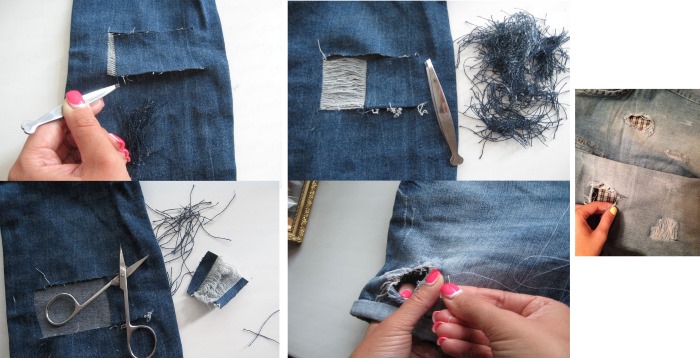
To prevent further unraveling of the fabric, as well as to renew the jeans, you need to make a patch from the inside. To do this, take the material from old jeans and make two horizontal cuts, the size of which will correspond to the hole being repaired. Then you need to carefully pull out the vertical threads.
Once the desired size has been reached, this patch should be cut out, leaving 1 cm on the sides. At the final stage, the cut out bookmark should be sewn on, placing it under the hole from the inside. Sew on with small stitches using a thread that matches the denim fabric. You can also sew a lining patch of a contrasting color along the edge of the hole.
Darning on a sewing machine
It is usually easier to darn jeans between the legs using a machine than by hand.
This type of repair will also last longer:
- To repair jeans, you need to properly prepare the patch area. You need to cut off all protruding threads. You also need to trim the edges of the hole so that the outline is clearly visible. This will help you not to miss important areas when making a patch.
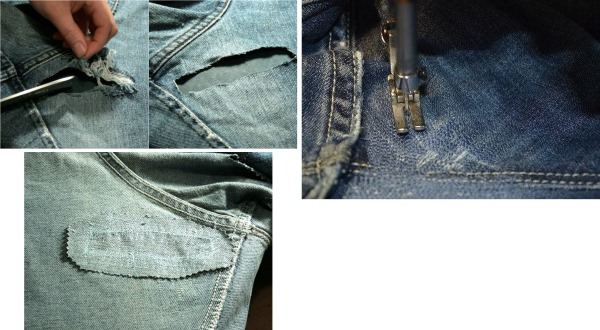
- Then you need to cut out a piece of denim fabric that matches the color and, preferably, the thickness. The piece should be 1 cm wider than the hole.
- The patch should be pinned on the back and sewn on with a few stitches on the machine. It is not recommended to baste the patch by hand, as it will be extremely difficult to remove the basting threads after darning.
- Darning should be done from the front side, placing the seams as close to each other as possible. Ideally, if you can repeat the direction of the threads of the denim fabric.
- Next, you need to fill the surface with stitches going in a perpendicular direction.
How to apply a patch
There are two ways to darn jeans between the legs using a machine.
Classic version
A hole or abrasion can be easily covered by making a regular fabric patch over the damage. A square patch is quick and easy to sew on, which is why it is the most popular.
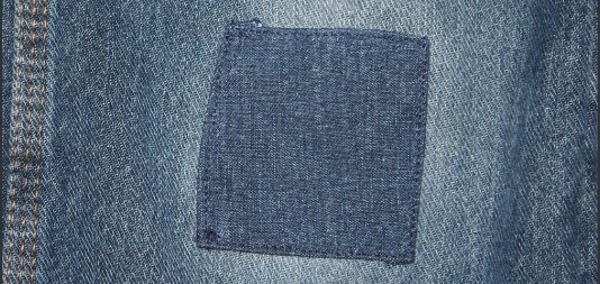
To make a square patch, you need to cut a square out of the fabric that will cover the hole, leaving 0.5-1 cm for hemming. Then the piece should be ironed, folding the edges and fastened to the jeans. Experienced craftswomen can use pins for this.
For those who are not confident using a sewing machine, it is better to baste the patch by hand. Then the square must be sewn to the jeans, placing the seams along the perimeter of the workpiece.
This method can be difficult if the hole is in a hard to reach place. In this case, you can simplify the work by slightly unpicking the nearest factory seam. After the hole is sewn up, all that remains is to carefully stitch the seam, choosing the right color thread.
Recovery
It is possible to mend jeans between the legs on a machine even when the damage is large and the patch option is no longer suitable. To do this, you should use the restoration method, which consists of completely replacing the damaged part of the product. In this case, the replacement should be done symmetrically.
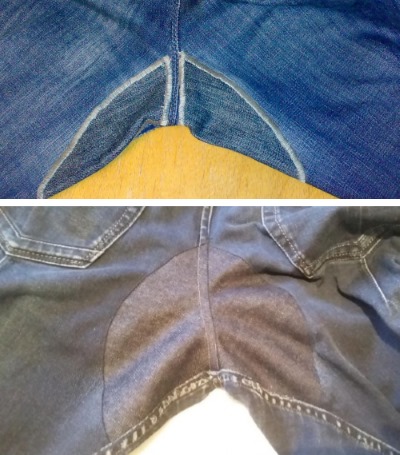
To work you will need:
- pieces of denim of a suitable color,
- threads of 2 colors: in the same tone as the jeans and matching the threads used to make the seams on the jeans by the manufacturer.
Stages of work:
- It is necessary to rip out part of the back seam running along the center, as well as the side seams.
- Cut out the frayed area of the pants.
- Next, cut out a piece of fabric of identical shape from the other side of the back seam.
- The cut out piece of denim must be applied to the prepared pieces and symmetrical details must be cut out.
- Then all the details need to be basted and carefully sewn into the jeans.
To prevent jeans from fraying in the crotch area, it is recommended to cut the insert parts so that the guide threads run diagonally. This will allow the fabric to stretch better.
You can also strengthen your jeans by using thick corduroy or leather instead of denim. To make the insert look natural, you can sew patches of similar fabric to other areas of the jeans.
How to mend a hole in jeans without a patch
You can darn jeans between the legs either with a machine or by hand. It all depends on the type of damage and its location.
For example, in some cases there is no need to sew a patch on the damaged jeans. If the hole is a straight line or resembles the letter "G", then it is recommended to darn it manually without using patches.
What you will need:
- The needle is of medium length or long.
- Threads that are matched closely to the tone of the denim fabric.
Stages of work:
- It is necessary to lay a line along the long side of the abrasion. If there are "native" threads of the fabric left on the damage, then the thread should be passed alternately under such a thread, then over the next thread.
At the end of the row, the needle should be threaded from the edge through 2-3 threads of the undamaged part of the fabric. When turning to the next edge, you need to maintain a balance - the indent from the edge of the hole should be minimal, but at the same time provide good fastening. This will make the darned area less noticeable, and will also prevent further unraveling of the fabric.
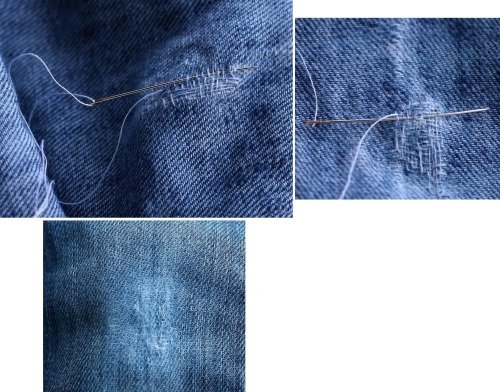
- The threads should be pulled as close to each other as possible. The density of the darning and its durability depend on this.
- Next, you need to continue darning along the short side of the hole. The needle should also be passed first under the thread located perpendicularly, then over the next thread. It is important to ensure that the fabric is dense, without gaps.
- If the thread color is chosen correctly and the darning is done correctly, the repaired area will be barely noticeable.
Other repair methods
A hole in your jeans is not always a reason to be upset.
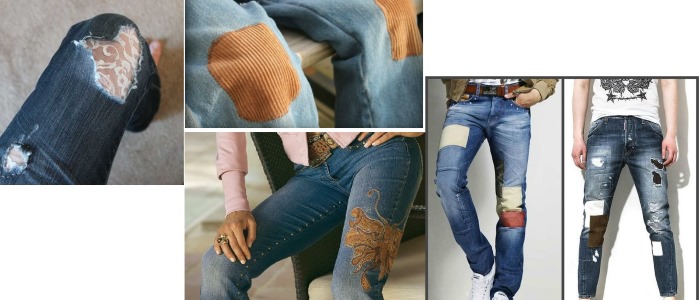
If you approach the problem creatively, you can create interesting and fashionable things.
How to hide a hole in jeans, fix it beautifully, decorate it
There can be many options when the hole is not just sewn up, but also decorated.
How to mend a hole in jeans between the legs
Machine darning between the legs of jeans may seem like a boring solution to the problem for some people. Especially when modern fashion welcomes street style.
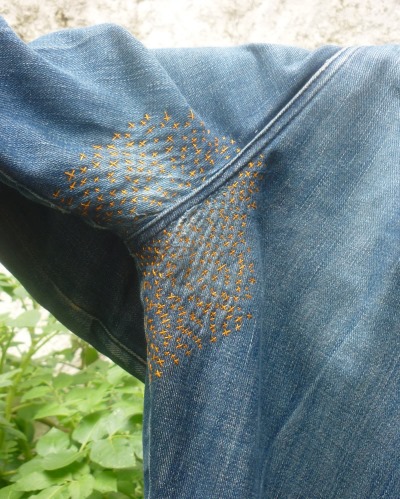
To take advantage of the opportunity and add a little zest to your favorite pants, you can choose a deliberately bright thread for darning or, using traditional darning, make sashiko stitches or any other embroidery.
How to fix a hole in your knee
You can decorate a torn knee using the Japanese sashiko technique. Sashiko embroidery is simple forward stitches made with a contrasting thread that can be done in any direction.
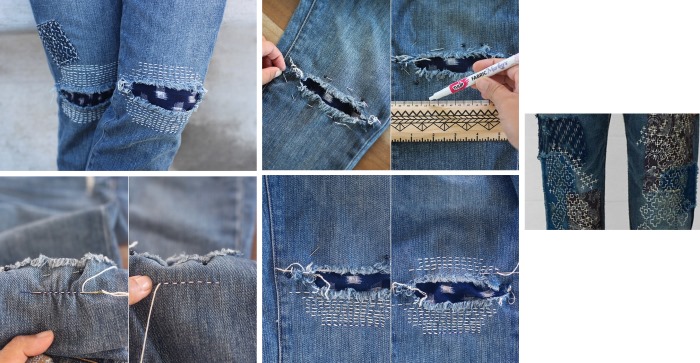
Stages of work:
- You need to cut out a rectangular piece from the desired fabric. This piece should be 3 cm larger than the hole.
- After placing the patch on the inside, baste it. Since the hole is on the knee, the patch fabric should not be stretched, otherwise it will be difficult to bend the knee.
- To ensure that the rows of sashiko stitches are even, it is recommended to draw lines with chalk, a piece of soap or a special washable marker.
- The stitches should be made short on the face and long on the back. In this case, a row of stitches should be made with a needle at once, gathering the fabric into an accordion.
- How many rows to make depends on the imagination of the craftswoman. The main thing is that they are enough to secure the patch on the knee.
How to remove a hole in the butt
It is not always necessary to darn or sew up holes using classical methods.

Damage to the buttocks of trousers hidden behind bright appliques or embroidery often looks more interesting and natural.
How to fix a hole in a pocket
Pockets on jeans often wear out. Back pockets due to friction against outerwear or chairs. Holes may appear on the front pockets when there is a habit of keeping hands in pockets or carrying small items in them.
Jeans will look fashionable if you don't hide the hole, but rather accentuate it. The only thing is that to prevent it from falling apart, you will need to secure the edges.
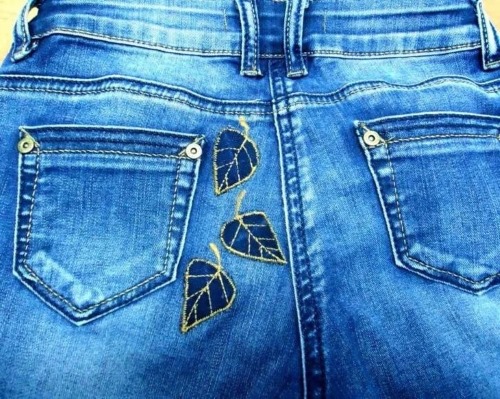
The hole can be given any shape, for example, in the form of a heart. A small abrasion on the pocket can be hidden behind embroidery made with simple stitches. Embroidery and appliques allow the imagination to "unfold" to the maximum.
There are many ways to sew up jeans between the legs. Some people find it easier to do it on a sewing machine, while others are better at hand sewing. If you have no sewing skills at all, you can glue on an applique.
Author: Vorobyova Nadezhda
Article formatting: Natalie Podolskaya
Video about ways to darn jeans
How to darn jeans between the legs - video instructions:
https://www.youtube.com/watch?v=l_clbeXb3Sc
